Role of Information Technology in Tesco PLC
VerifiedAdded on 2023/01/13
|12
|3862
|77
AI Summary
This report discusses the role of information technology in Tesco PLC and its impact on the competitive advantage of the organization. It includes an analysis of Porter's five forces, inbound logistics, outbound logistics, and operations. The report also examines the activities on Porter's value chain and identifies key activities adding value to Tesco PLC.
Contribute Materials
Your contribution can guide someone’s learning journey. Share your
documents today.
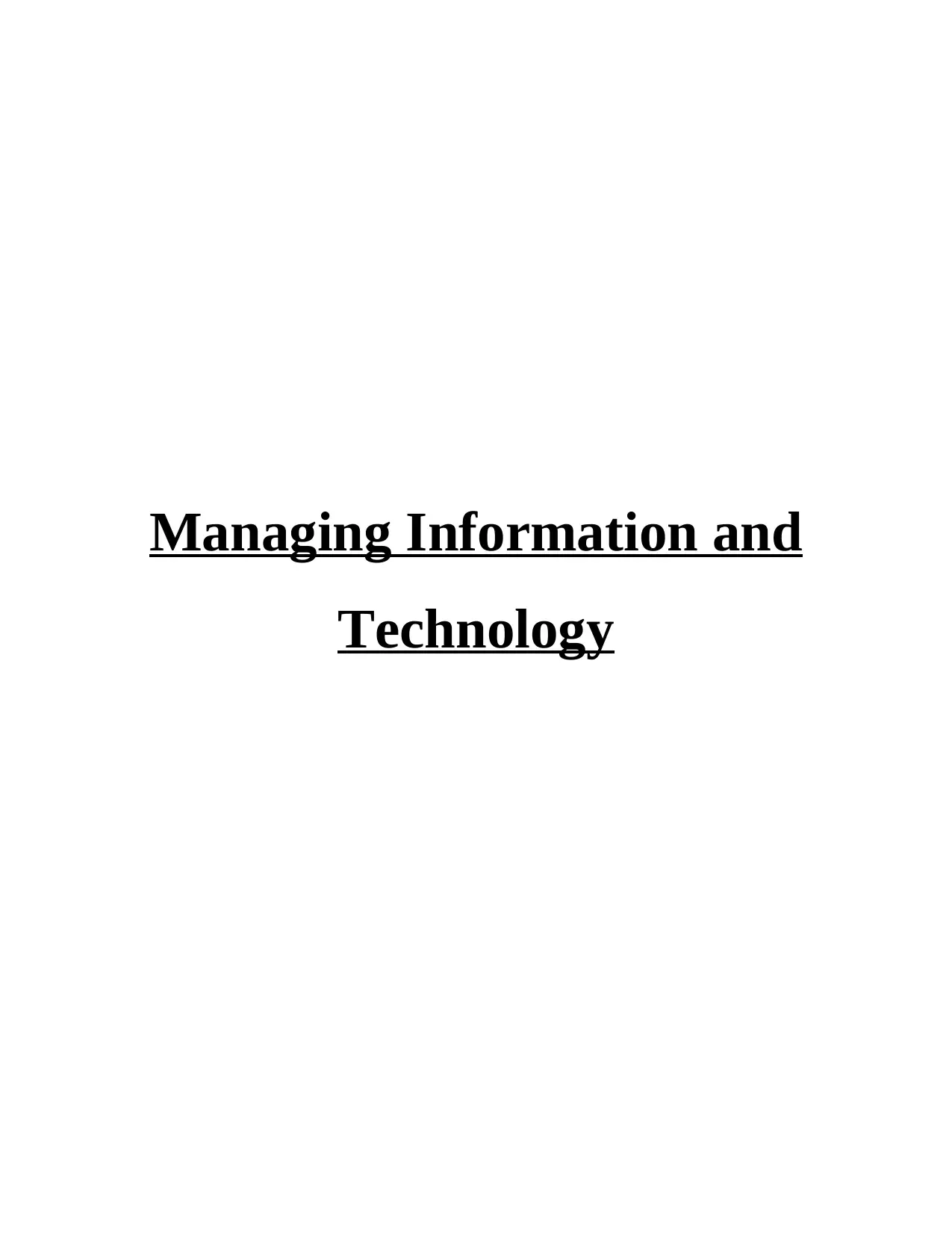
Managing Information and
Technology
Technology
Secure Best Marks with AI Grader
Need help grading? Try our AI Grader for instant feedback on your assignments.
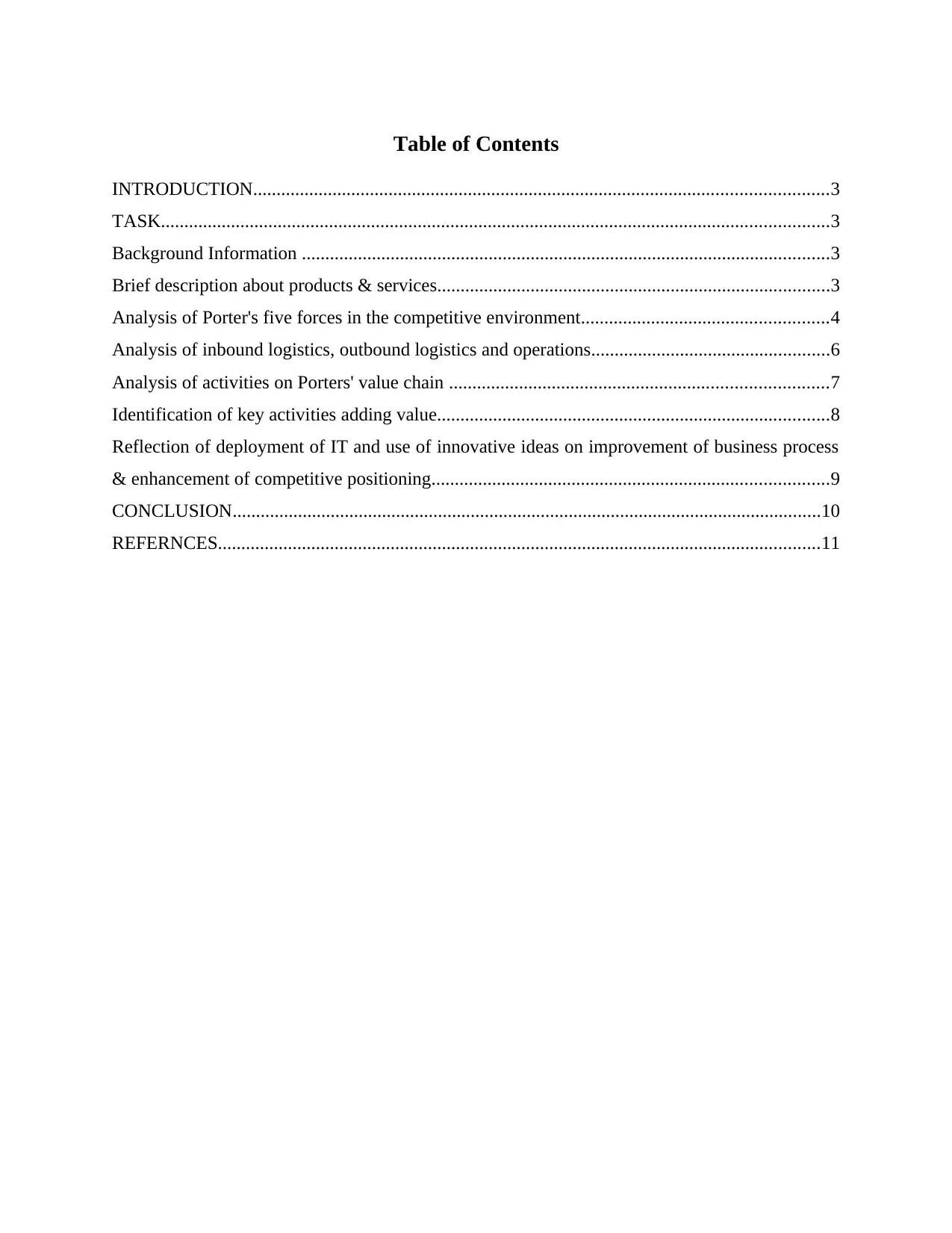
Table of Contents
INTRODUCTION...........................................................................................................................3
TASK...............................................................................................................................................3
Background Information .................................................................................................................3
Brief description about products & services....................................................................................3
Analysis of Porter's five forces in the competitive environment.....................................................4
Analysis of inbound logistics, outbound logistics and operations...................................................6
Analysis of activities on Porters' value chain .................................................................................7
Identification of key activities adding value....................................................................................8
Reflection of deployment of IT and use of innovative ideas on improvement of business process
& enhancement of competitive positioning.....................................................................................9
CONCLUSION..............................................................................................................................10
REFERNCES.................................................................................................................................11
INTRODUCTION...........................................................................................................................3
TASK...............................................................................................................................................3
Background Information .................................................................................................................3
Brief description about products & services....................................................................................3
Analysis of Porter's five forces in the competitive environment.....................................................4
Analysis of inbound logistics, outbound logistics and operations...................................................6
Analysis of activities on Porters' value chain .................................................................................7
Identification of key activities adding value....................................................................................8
Reflection of deployment of IT and use of innovative ideas on improvement of business process
& enhancement of competitive positioning.....................................................................................9
CONCLUSION..............................................................................................................................10
REFERNCES.................................................................................................................................11
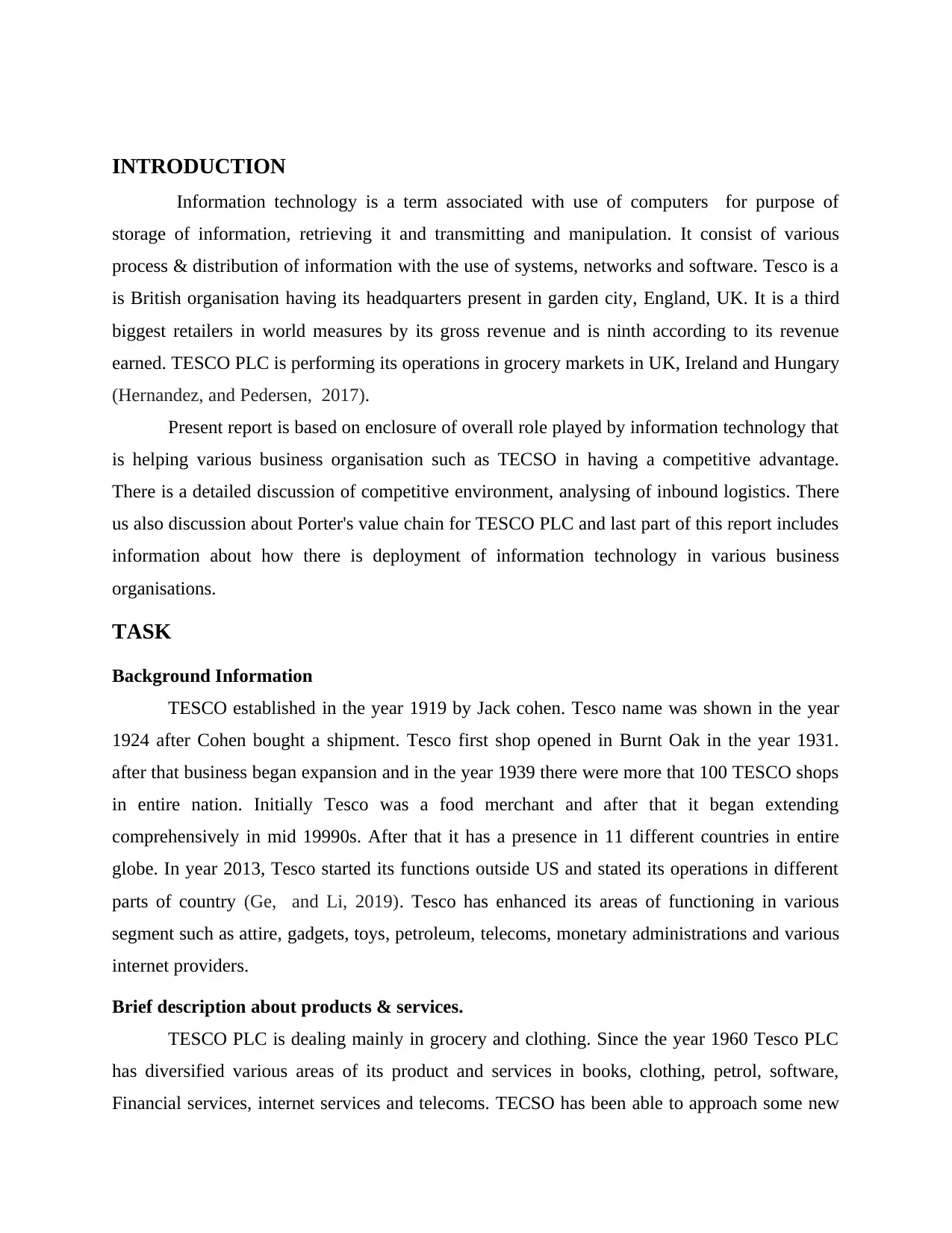
INTRODUCTION
Information technology is a term associated with use of computers for purpose of
storage of information, retrieving it and transmitting and manipulation. It consist of various
process & distribution of information with the use of systems, networks and software. Tesco is a
is British organisation having its headquarters present in garden city, England, UK. It is a third
biggest retailers in world measures by its gross revenue and is ninth according to its revenue
earned. TESCO PLC is performing its operations in grocery markets in UK, Ireland and Hungary
(Hernandez, and Pedersen, 2017).
Present report is based on enclosure of overall role played by information technology that
is helping various business organisation such as TECSO in having a competitive advantage.
There is a detailed discussion of competitive environment, analysing of inbound logistics. There
us also discussion about Porter's value chain for TESCO PLC and last part of this report includes
information about how there is deployment of information technology in various business
organisations.
TASK
Background Information
TESCO established in the year 1919 by Jack cohen. Tesco name was shown in the year
1924 after Cohen bought a shipment. Tesco first shop opened in Burnt Oak in the year 1931.
after that business began expansion and in the year 1939 there were more that 100 TESCO shops
in entire nation. Initially Tesco was a food merchant and after that it began extending
comprehensively in mid 19990s. After that it has a presence in 11 different countries in entire
globe. In year 2013, Tesco started its functions outside US and stated its operations in different
parts of country (Ge, and Li, 2019). Tesco has enhanced its areas of functioning in various
segment such as attire, gadgets, toys, petroleum, telecoms, monetary administrations and various
internet providers.
Brief description about products & services.
TESCO PLC is dealing mainly in grocery and clothing. Since the year 1960 Tesco PLC
has diversified various areas of its product and services in books, clothing, petrol, software,
Financial services, internet services and telecoms. TECSO has been able to approach some new
Information technology is a term associated with use of computers for purpose of
storage of information, retrieving it and transmitting and manipulation. It consist of various
process & distribution of information with the use of systems, networks and software. Tesco is a
is British organisation having its headquarters present in garden city, England, UK. It is a third
biggest retailers in world measures by its gross revenue and is ninth according to its revenue
earned. TESCO PLC is performing its operations in grocery markets in UK, Ireland and Hungary
(Hernandez, and Pedersen, 2017).
Present report is based on enclosure of overall role played by information technology that
is helping various business organisation such as TECSO in having a competitive advantage.
There is a detailed discussion of competitive environment, analysing of inbound logistics. There
us also discussion about Porter's value chain for TESCO PLC and last part of this report includes
information about how there is deployment of information technology in various business
organisations.
TASK
Background Information
TESCO established in the year 1919 by Jack cohen. Tesco name was shown in the year
1924 after Cohen bought a shipment. Tesco first shop opened in Burnt Oak in the year 1931.
after that business began expansion and in the year 1939 there were more that 100 TESCO shops
in entire nation. Initially Tesco was a food merchant and after that it began extending
comprehensively in mid 19990s. After that it has a presence in 11 different countries in entire
globe. In year 2013, Tesco started its functions outside US and stated its operations in different
parts of country (Ge, and Li, 2019). Tesco has enhanced its areas of functioning in various
segment such as attire, gadgets, toys, petroleum, telecoms, monetary administrations and various
internet providers.
Brief description about products & services.
TESCO PLC is dealing mainly in grocery and clothing. Since the year 1960 Tesco PLC
has diversified various areas of its product and services in books, clothing, petrol, software,
Financial services, internet services and telecoms. TECSO has been able to approach some new
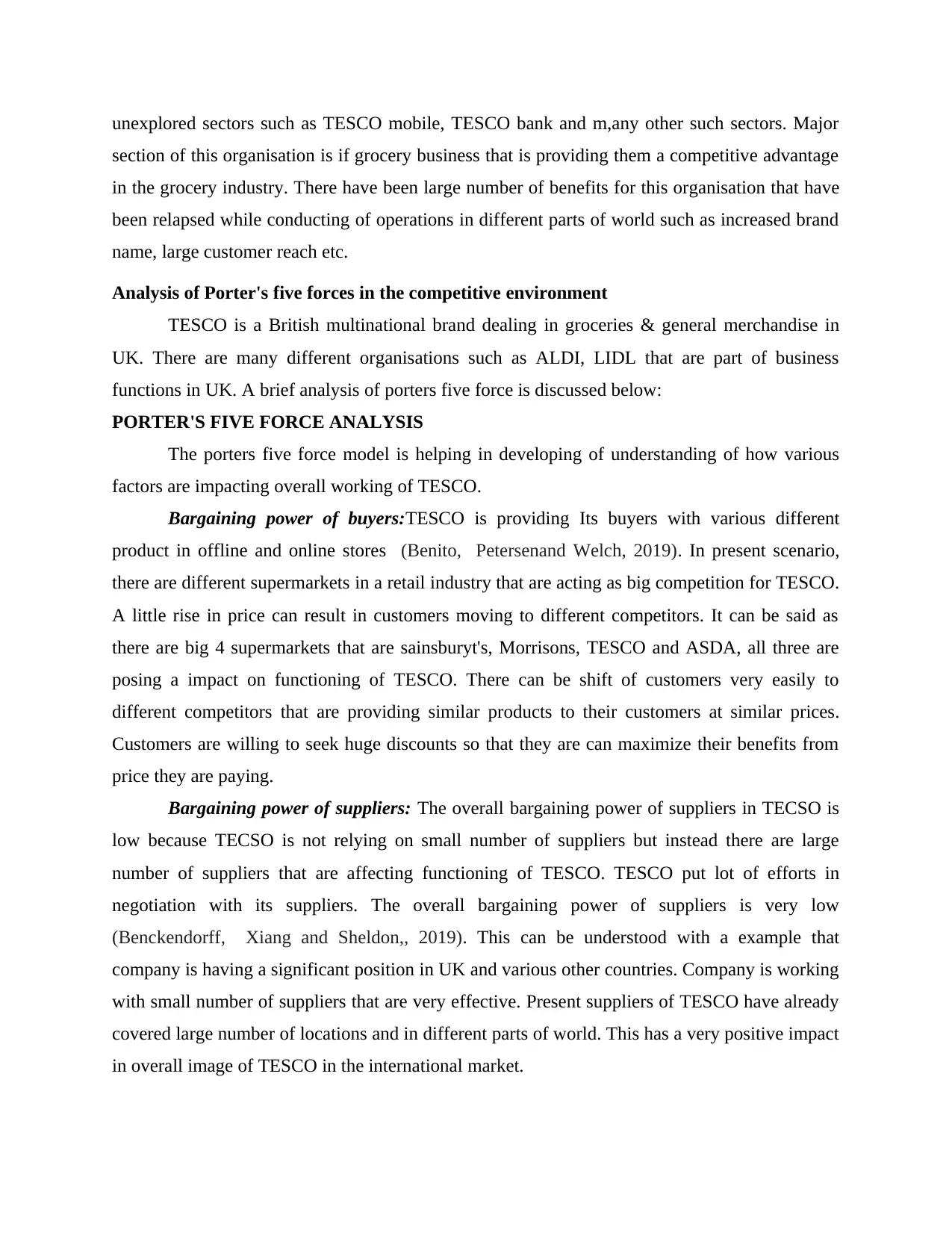
unexplored sectors such as TESCO mobile, TESCO bank and m,any other such sectors. Major
section of this organisation is if grocery business that is providing them a competitive advantage
in the grocery industry. There have been large number of benefits for this organisation that have
been relapsed while conducting of operations in different parts of world such as increased brand
name, large customer reach etc.
Analysis of Porter's five forces in the competitive environment
TESCO is a British multinational brand dealing in groceries & general merchandise in
UK. There are many different organisations such as ALDI, LIDL that are part of business
functions in UK. A brief analysis of porters five force is discussed below:
PORTER'S FIVE FORCE ANALYSIS
The porters five force model is helping in developing of understanding of how various
factors are impacting overall working of TESCO.
Bargaining power of buyers:TESCO is providing Its buyers with various different
product in offline and online stores (Benito, Petersenand Welch, 2019). In present scenario,
there are different supermarkets in a retail industry that are acting as big competition for TESCO.
A little rise in price can result in customers moving to different competitors. It can be said as
there are big 4 supermarkets that are sainsburyt's, Morrisons, TESCO and ASDA, all three are
posing a impact on functioning of TESCO. There can be shift of customers very easily to
different competitors that are providing similar products to their customers at similar prices.
Customers are willing to seek huge discounts so that they are can maximize their benefits from
price they are paying.
Bargaining power of suppliers: The overall bargaining power of suppliers in TECSO is
low because TECSO is not relying on small number of suppliers but instead there are large
number of suppliers that are affecting functioning of TESCO. TESCO put lot of efforts in
negotiation with its suppliers. The overall bargaining power of suppliers is very low
(Benckendorff, Xiang and Sheldon,, 2019). This can be understood with a example that
company is having a significant position in UK and various other countries. Company is working
with small number of suppliers that are very effective. Present suppliers of TESCO have already
covered large number of locations and in different parts of world. This has a very positive impact
in overall image of TESCO in the international market.
section of this organisation is if grocery business that is providing them a competitive advantage
in the grocery industry. There have been large number of benefits for this organisation that have
been relapsed while conducting of operations in different parts of world such as increased brand
name, large customer reach etc.
Analysis of Porter's five forces in the competitive environment
TESCO is a British multinational brand dealing in groceries & general merchandise in
UK. There are many different organisations such as ALDI, LIDL that are part of business
functions in UK. A brief analysis of porters five force is discussed below:
PORTER'S FIVE FORCE ANALYSIS
The porters five force model is helping in developing of understanding of how various
factors are impacting overall working of TESCO.
Bargaining power of buyers:TESCO is providing Its buyers with various different
product in offline and online stores (Benito, Petersenand Welch, 2019). In present scenario,
there are different supermarkets in a retail industry that are acting as big competition for TESCO.
A little rise in price can result in customers moving to different competitors. It can be said as
there are big 4 supermarkets that are sainsburyt's, Morrisons, TESCO and ASDA, all three are
posing a impact on functioning of TESCO. There can be shift of customers very easily to
different competitors that are providing similar products to their customers at similar prices.
Customers are willing to seek huge discounts so that they are can maximize their benefits from
price they are paying.
Bargaining power of suppliers: The overall bargaining power of suppliers in TECSO is
low because TECSO is not relying on small number of suppliers but instead there are large
number of suppliers that are affecting functioning of TESCO. TESCO put lot of efforts in
negotiation with its suppliers. The overall bargaining power of suppliers is very low
(Benckendorff, Xiang and Sheldon,, 2019). This can be understood with a example that
company is having a significant position in UK and various other countries. Company is working
with small number of suppliers that are very effective. Present suppliers of TESCO have already
covered large number of locations and in different parts of world. This has a very positive impact
in overall image of TESCO in the international market.
Secure Best Marks with AI Grader
Need help grading? Try our AI Grader for instant feedback on your assignments.
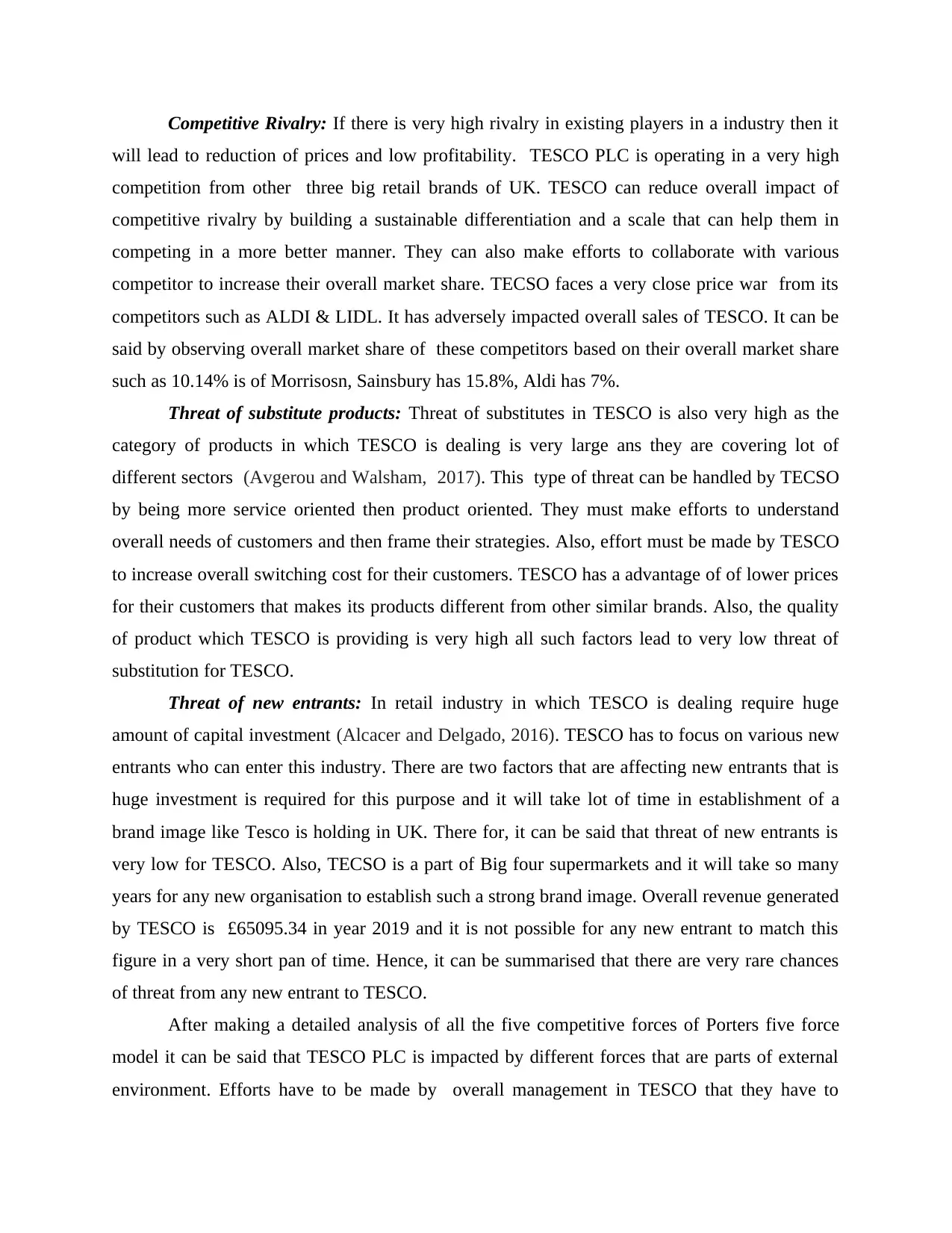
Competitive Rivalry: If there is very high rivalry in existing players in a industry then it
will lead to reduction of prices and low profitability. TESCO PLC is operating in a very high
competition from other three big retail brands of UK. TESCO can reduce overall impact of
competitive rivalry by building a sustainable differentiation and a scale that can help them in
competing in a more better manner. They can also make efforts to collaborate with various
competitor to increase their overall market share. TECSO faces a very close price war from its
competitors such as ALDI & LIDL. It has adversely impacted overall sales of TESCO. It can be
said by observing overall market share of these competitors based on their overall market share
such as 10.14% is of Morrisosn, Sainsbury has 15.8%, Aldi has 7%.
Threat of substitute products: Threat of substitutes in TESCO is also very high as the
category of products in which TESCO is dealing is very large ans they are covering lot of
different sectors (Avgerou and Walsham, 2017). This type of threat can be handled by TECSO
by being more service oriented then product oriented. They must make efforts to understand
overall needs of customers and then frame their strategies. Also, effort must be made by TESCO
to increase overall switching cost for their customers. TESCO has a advantage of of lower prices
for their customers that makes its products different from other similar brands. Also, the quality
of product which TESCO is providing is very high all such factors lead to very low threat of
substitution for TESCO.
Threat of new entrants: In retail industry in which TESCO is dealing require huge
amount of capital investment (Alcacer and Delgado, 2016). TESCO has to focus on various new
entrants who can enter this industry. There are two factors that are affecting new entrants that is
huge investment is required for this purpose and it will take lot of time in establishment of a
brand image like Tesco is holding in UK. There for, it can be said that threat of new entrants is
very low for TESCO. Also, TECSO is a part of Big four supermarkets and it will take so many
years for any new organisation to establish such a strong brand image. Overall revenue generated
by TESCO is £65095.34 in year 2019 and it is not possible for any new entrant to match this
figure in a very short pan of time. Hence, it can be summarised that there are very rare chances
of threat from any new entrant to TESCO.
After making a detailed analysis of all the five competitive forces of Porters five force
model it can be said that TESCO PLC is impacted by different forces that are parts of external
environment. Efforts have to be made by overall management in TESCO that they have to
will lead to reduction of prices and low profitability. TESCO PLC is operating in a very high
competition from other three big retail brands of UK. TESCO can reduce overall impact of
competitive rivalry by building a sustainable differentiation and a scale that can help them in
competing in a more better manner. They can also make efforts to collaborate with various
competitor to increase their overall market share. TECSO faces a very close price war from its
competitors such as ALDI & LIDL. It has adversely impacted overall sales of TESCO. It can be
said by observing overall market share of these competitors based on their overall market share
such as 10.14% is of Morrisosn, Sainsbury has 15.8%, Aldi has 7%.
Threat of substitute products: Threat of substitutes in TESCO is also very high as the
category of products in which TESCO is dealing is very large ans they are covering lot of
different sectors (Avgerou and Walsham, 2017). This type of threat can be handled by TECSO
by being more service oriented then product oriented. They must make efforts to understand
overall needs of customers and then frame their strategies. Also, effort must be made by TESCO
to increase overall switching cost for their customers. TESCO has a advantage of of lower prices
for their customers that makes its products different from other similar brands. Also, the quality
of product which TESCO is providing is very high all such factors lead to very low threat of
substitution for TESCO.
Threat of new entrants: In retail industry in which TESCO is dealing require huge
amount of capital investment (Alcacer and Delgado, 2016). TESCO has to focus on various new
entrants who can enter this industry. There are two factors that are affecting new entrants that is
huge investment is required for this purpose and it will take lot of time in establishment of a
brand image like Tesco is holding in UK. There for, it can be said that threat of new entrants is
very low for TESCO. Also, TECSO is a part of Big four supermarkets and it will take so many
years for any new organisation to establish such a strong brand image. Overall revenue generated
by TESCO is £65095.34 in year 2019 and it is not possible for any new entrant to match this
figure in a very short pan of time. Hence, it can be summarised that there are very rare chances
of threat from any new entrant to TESCO.
After making a detailed analysis of all the five competitive forces of Porters five force
model it can be said that TESCO PLC is impacted by different forces that are parts of external
environment. Efforts have to be made by overall management in TESCO that they have to
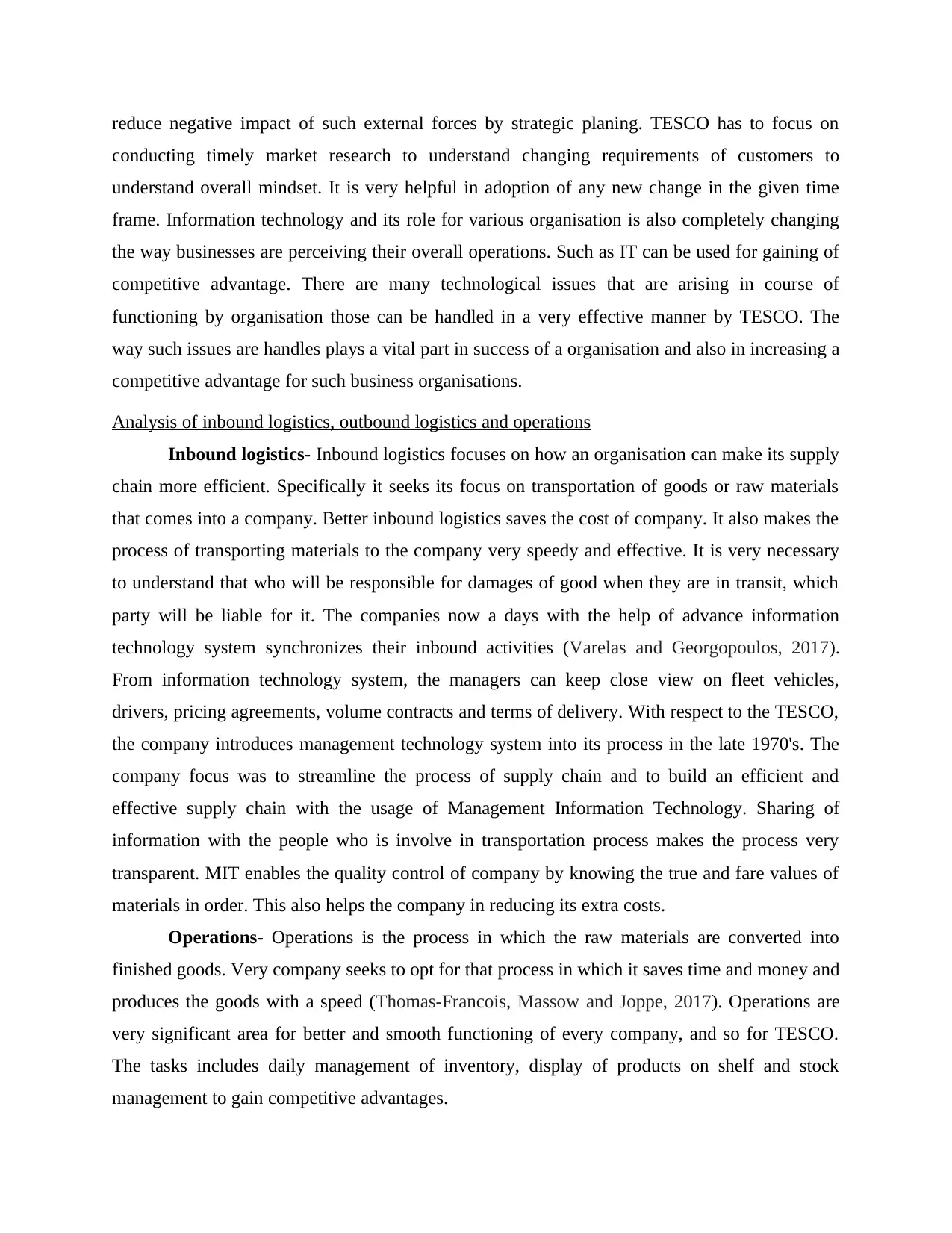
reduce negative impact of such external forces by strategic planing. TESCO has to focus on
conducting timely market research to understand changing requirements of customers to
understand overall mindset. It is very helpful in adoption of any new change in the given time
frame. Information technology and its role for various organisation is also completely changing
the way businesses are perceiving their overall operations. Such as IT can be used for gaining of
competitive advantage. There are many technological issues that are arising in course of
functioning by organisation those can be handled in a very effective manner by TESCO. The
way such issues are handles plays a vital part in success of a organisation and also in increasing a
competitive advantage for such business organisations.
Analysis of inbound logistics, outbound logistics and operations
Inbound logistics- Inbound logistics focuses on how an organisation can make its supply
chain more efficient. Specifically it seeks its focus on transportation of goods or raw materials
that comes into a company. Better inbound logistics saves the cost of company. It also makes the
process of transporting materials to the company very speedy and effective. It is very necessary
to understand that who will be responsible for damages of good when they are in transit, which
party will be liable for it. The companies now a days with the help of advance information
technology system synchronizes their inbound activities (Varelas and Georgopoulos, 2017).
From information technology system, the managers can keep close view on fleet vehicles,
drivers, pricing agreements, volume contracts and terms of delivery. With respect to the TESCO,
the company introduces management technology system into its process in the late 1970's. The
company focus was to streamline the process of supply chain and to build an efficient and
effective supply chain with the usage of Management Information Technology. Sharing of
information with the people who is involve in transportation process makes the process very
transparent. MIT enables the quality control of company by knowing the true and fare values of
materials in order. This also helps the company in reducing its extra costs.
Operations- Operations is the process in which the raw materials are converted into
finished goods. Very company seeks to opt for that process in which it saves time and money and
produces the goods with a speed (Thomas-Francois, Massow and Joppe, 2017). Operations are
very significant area for better and smooth functioning of every company, and so for TESCO.
The tasks includes daily management of inventory, display of products on shelf and stock
management to gain competitive advantages.
conducting timely market research to understand changing requirements of customers to
understand overall mindset. It is very helpful in adoption of any new change in the given time
frame. Information technology and its role for various organisation is also completely changing
the way businesses are perceiving their overall operations. Such as IT can be used for gaining of
competitive advantage. There are many technological issues that are arising in course of
functioning by organisation those can be handled in a very effective manner by TESCO. The
way such issues are handles plays a vital part in success of a organisation and also in increasing a
competitive advantage for such business organisations.
Analysis of inbound logistics, outbound logistics and operations
Inbound logistics- Inbound logistics focuses on how an organisation can make its supply
chain more efficient. Specifically it seeks its focus on transportation of goods or raw materials
that comes into a company. Better inbound logistics saves the cost of company. It also makes the
process of transporting materials to the company very speedy and effective. It is very necessary
to understand that who will be responsible for damages of good when they are in transit, which
party will be liable for it. The companies now a days with the help of advance information
technology system synchronizes their inbound activities (Varelas and Georgopoulos, 2017).
From information technology system, the managers can keep close view on fleet vehicles,
drivers, pricing agreements, volume contracts and terms of delivery. With respect to the TESCO,
the company introduces management technology system into its process in the late 1970's. The
company focus was to streamline the process of supply chain and to build an efficient and
effective supply chain with the usage of Management Information Technology. Sharing of
information with the people who is involve in transportation process makes the process very
transparent. MIT enables the quality control of company by knowing the true and fare values of
materials in order. This also helps the company in reducing its extra costs.
Operations- Operations is the process in which the raw materials are converted into
finished goods. Very company seeks to opt for that process in which it saves time and money and
produces the goods with a speed (Thomas-Francois, Massow and Joppe, 2017). Operations are
very significant area for better and smooth functioning of every company, and so for TESCO.
The tasks includes daily management of inventory, display of products on shelf and stock
management to gain competitive advantages.
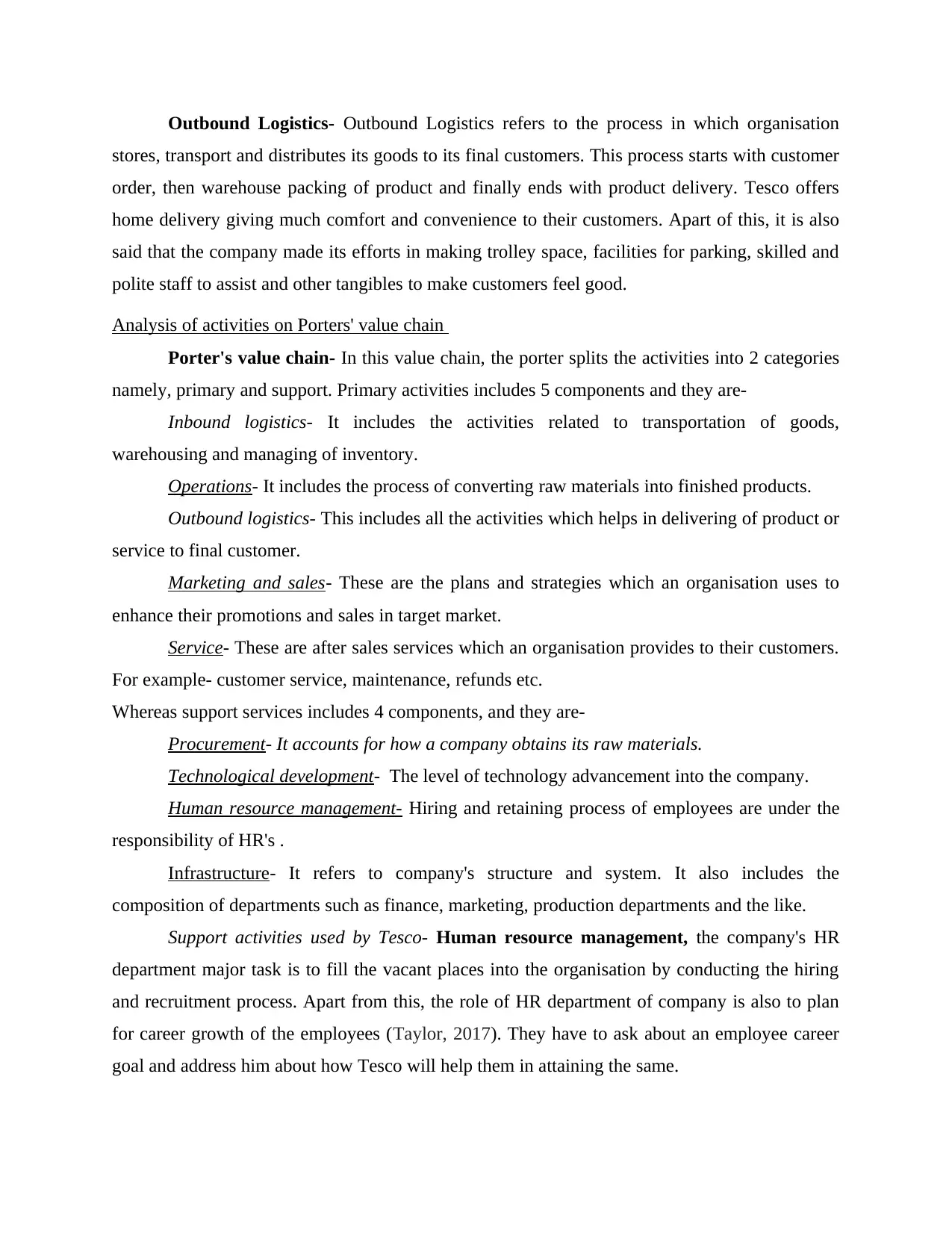
Outbound Logistics- Outbound Logistics refers to the process in which organisation
stores, transport and distributes its goods to its final customers. This process starts with customer
order, then warehouse packing of product and finally ends with product delivery. Tesco offers
home delivery giving much comfort and convenience to their customers. Apart of this, it is also
said that the company made its efforts in making trolley space, facilities for parking, skilled and
polite staff to assist and other tangibles to make customers feel good.
Analysis of activities on Porters' value chain
Porter's value chain- In this value chain, the porter splits the activities into 2 categories
namely, primary and support. Primary activities includes 5 components and they are-
Inbound logistics- It includes the activities related to transportation of goods,
warehousing and managing of inventory.
Operations- It includes the process of converting raw materials into finished products.
Outbound logistics- This includes all the activities which helps in delivering of product or
service to final customer.
Marketing and sales- These are the plans and strategies which an organisation uses to
enhance their promotions and sales in target market.
Service- These are after sales services which an organisation provides to their customers.
For example- customer service, maintenance, refunds etc.
Whereas support services includes 4 components, and they are-
Procurement- It accounts for how a company obtains its raw materials.
Technological development- The level of technology advancement into the company.
Human resource management- Hiring and retaining process of employees are under the
responsibility of HR's .
Infrastructure- It refers to company's structure and system. It also includes the
composition of departments such as finance, marketing, production departments and the like.
Support activities used by Tesco- Human resource management, the company's HR
department major task is to fill the vacant places into the organisation by conducting the hiring
and recruitment process. Apart from this, the role of HR department of company is also to plan
for career growth of the employees (Taylor, 2017). They have to ask about an employee career
goal and address him about how Tesco will help them in attaining the same.
stores, transport and distributes its goods to its final customers. This process starts with customer
order, then warehouse packing of product and finally ends with product delivery. Tesco offers
home delivery giving much comfort and convenience to their customers. Apart of this, it is also
said that the company made its efforts in making trolley space, facilities for parking, skilled and
polite staff to assist and other tangibles to make customers feel good.
Analysis of activities on Porters' value chain
Porter's value chain- In this value chain, the porter splits the activities into 2 categories
namely, primary and support. Primary activities includes 5 components and they are-
Inbound logistics- It includes the activities related to transportation of goods,
warehousing and managing of inventory.
Operations- It includes the process of converting raw materials into finished products.
Outbound logistics- This includes all the activities which helps in delivering of product or
service to final customer.
Marketing and sales- These are the plans and strategies which an organisation uses to
enhance their promotions and sales in target market.
Service- These are after sales services which an organisation provides to their customers.
For example- customer service, maintenance, refunds etc.
Whereas support services includes 4 components, and they are-
Procurement- It accounts for how a company obtains its raw materials.
Technological development- The level of technology advancement into the company.
Human resource management- Hiring and retaining process of employees are under the
responsibility of HR's .
Infrastructure- It refers to company's structure and system. It also includes the
composition of departments such as finance, marketing, production departments and the like.
Support activities used by Tesco- Human resource management, the company's HR
department major task is to fill the vacant places into the organisation by conducting the hiring
and recruitment process. Apart from this, the role of HR department of company is also to plan
for career growth of the employees (Taylor, 2017). They have to ask about an employee career
goal and address him about how Tesco will help them in attaining the same.
Paraphrase This Document
Need a fresh take? Get an instant paraphrase of this document with our AI Paraphraser
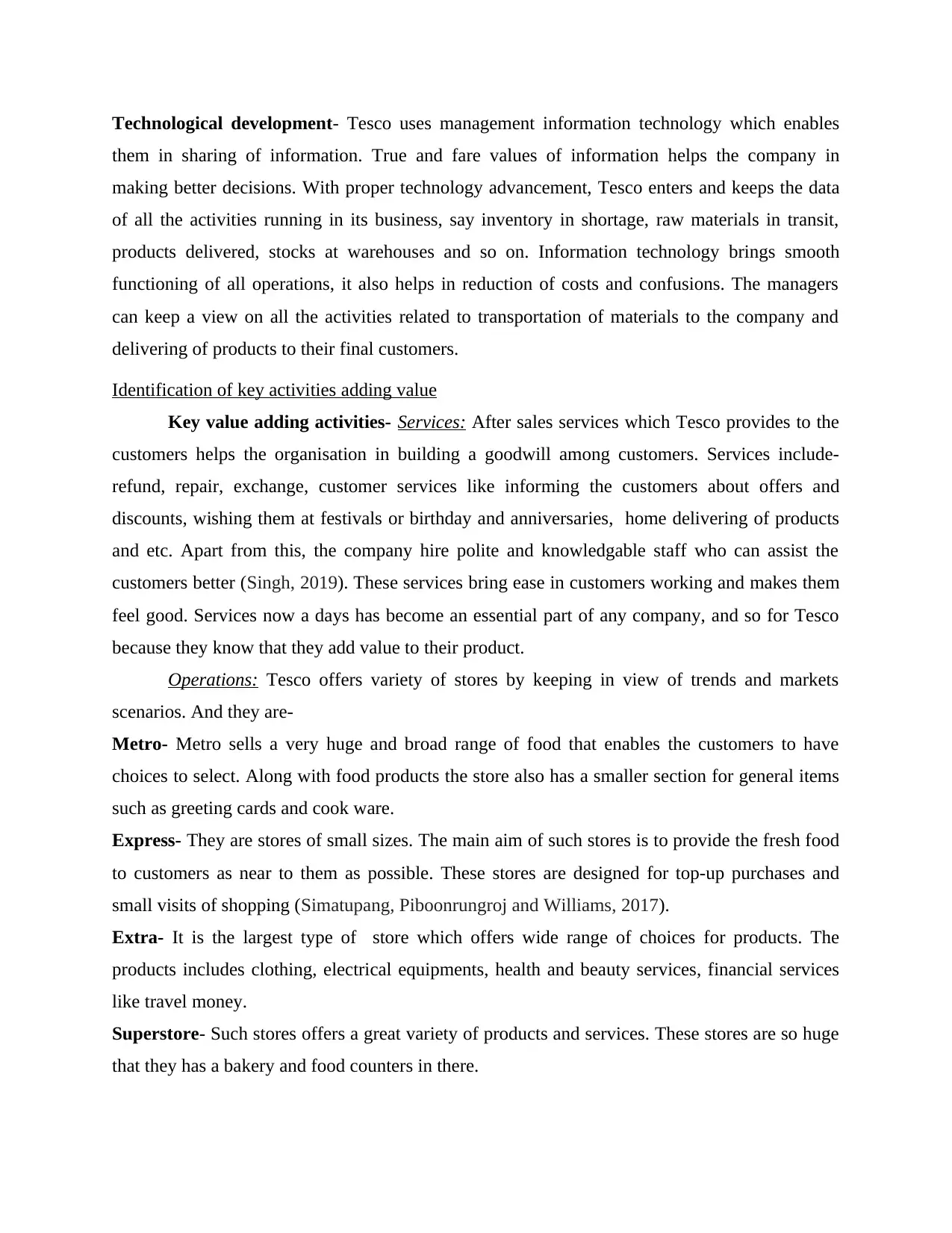
Technological development- Tesco uses management information technology which enables
them in sharing of information. True and fare values of information helps the company in
making better decisions. With proper technology advancement, Tesco enters and keeps the data
of all the activities running in its business, say inventory in shortage, raw materials in transit,
products delivered, stocks at warehouses and so on. Information technology brings smooth
functioning of all operations, it also helps in reduction of costs and confusions. The managers
can keep a view on all the activities related to transportation of materials to the company and
delivering of products to their final customers.
Identification of key activities adding value
Key value adding activities- Services: After sales services which Tesco provides to the
customers helps the organisation in building a goodwill among customers. Services include-
refund, repair, exchange, customer services like informing the customers about offers and
discounts, wishing them at festivals or birthday and anniversaries, home delivering of products
and etc. Apart from this, the company hire polite and knowledgable staff who can assist the
customers better (Singh, 2019). These services bring ease in customers working and makes them
feel good. Services now a days has become an essential part of any company, and so for Tesco
because they know that they add value to their product.
Operations: Tesco offers variety of stores by keeping in view of trends and markets
scenarios. And they are-
Metro- Metro sells a very huge and broad range of food that enables the customers to have
choices to select. Along with food products the store also has a smaller section for general items
such as greeting cards and cook ware.
Express- They are stores of small sizes. The main aim of such stores is to provide the fresh food
to customers as near to them as possible. These stores are designed for top-up purchases and
small visits of shopping (Simatupang, Piboonrungroj and Williams, 2017).
Extra- It is the largest type of store which offers wide range of choices for products. The
products includes clothing, electrical equipments, health and beauty services, financial services
like travel money.
Superstore- Such stores offers a great variety of products and services. These stores are so huge
that they has a bakery and food counters in there.
them in sharing of information. True and fare values of information helps the company in
making better decisions. With proper technology advancement, Tesco enters and keeps the data
of all the activities running in its business, say inventory in shortage, raw materials in transit,
products delivered, stocks at warehouses and so on. Information technology brings smooth
functioning of all operations, it also helps in reduction of costs and confusions. The managers
can keep a view on all the activities related to transportation of materials to the company and
delivering of products to their final customers.
Identification of key activities adding value
Key value adding activities- Services: After sales services which Tesco provides to the
customers helps the organisation in building a goodwill among customers. Services include-
refund, repair, exchange, customer services like informing the customers about offers and
discounts, wishing them at festivals or birthday and anniversaries, home delivering of products
and etc. Apart from this, the company hire polite and knowledgable staff who can assist the
customers better (Singh, 2019). These services bring ease in customers working and makes them
feel good. Services now a days has become an essential part of any company, and so for Tesco
because they know that they add value to their product.
Operations: Tesco offers variety of stores by keeping in view of trends and markets
scenarios. And they are-
Metro- Metro sells a very huge and broad range of food that enables the customers to have
choices to select. Along with food products the store also has a smaller section for general items
such as greeting cards and cook ware.
Express- They are stores of small sizes. The main aim of such stores is to provide the fresh food
to customers as near to them as possible. These stores are designed for top-up purchases and
small visits of shopping (Simatupang, Piboonrungroj and Williams, 2017).
Extra- It is the largest type of store which offers wide range of choices for products. The
products includes clothing, electrical equipments, health and beauty services, financial services
like travel money.
Superstore- Such stores offers a great variety of products and services. These stores are so huge
that they has a bakery and food counters in there.
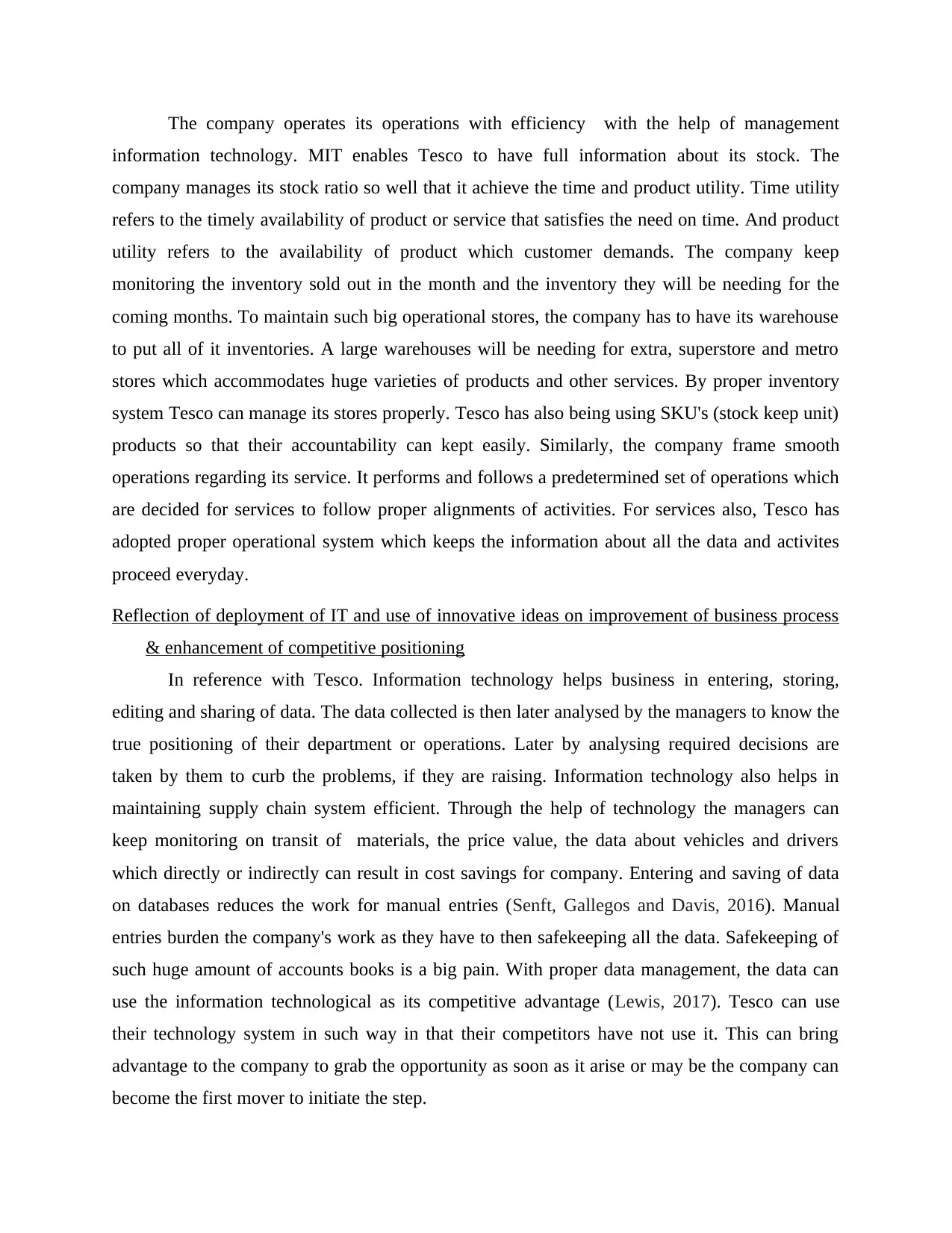
The company operates its operations with efficiency with the help of management
information technology. MIT enables Tesco to have full information about its stock. The
company manages its stock ratio so well that it achieve the time and product utility. Time utility
refers to the timely availability of product or service that satisfies the need on time. And product
utility refers to the availability of product which customer demands. The company keep
monitoring the inventory sold out in the month and the inventory they will be needing for the
coming months. To maintain such big operational stores, the company has to have its warehouse
to put all of it inventories. A large warehouses will be needing for extra, superstore and metro
stores which accommodates huge varieties of products and other services. By proper inventory
system Tesco can manage its stores properly. Tesco has also being using SKU's (stock keep unit)
products so that their accountability can kept easily. Similarly, the company frame smooth
operations regarding its service. It performs and follows a predetermined set of operations which
are decided for services to follow proper alignments of activities. For services also, Tesco has
adopted proper operational system which keeps the information about all the data and activites
proceed everyday.
Reflection of deployment of IT and use of innovative ideas on improvement of business process
& enhancement of competitive positioning
In reference with Tesco. Information technology helps business in entering, storing,
editing and sharing of data. The data collected is then later analysed by the managers to know the
true positioning of their department or operations. Later by analysing required decisions are
taken by them to curb the problems, if they are raising. Information technology also helps in
maintaining supply chain system efficient. Through the help of technology the managers can
keep monitoring on transit of materials, the price value, the data about vehicles and drivers
which directly or indirectly can result in cost savings for company. Entering and saving of data
on databases reduces the work for manual entries (Senft, Gallegos and Davis, 2016). Manual
entries burden the company's work as they have to then safekeeping all the data. Safekeeping of
such huge amount of accounts books is a big pain. With proper data management, the data can
use the information technological as its competitive advantage (Lewis, 2017). Tesco can use
their technology system in such way in that their competitors have not use it. This can bring
advantage to the company to grab the opportunity as soon as it arise or may be the company can
become the first mover to initiate the step.
information technology. MIT enables Tesco to have full information about its stock. The
company manages its stock ratio so well that it achieve the time and product utility. Time utility
refers to the timely availability of product or service that satisfies the need on time. And product
utility refers to the availability of product which customer demands. The company keep
monitoring the inventory sold out in the month and the inventory they will be needing for the
coming months. To maintain such big operational stores, the company has to have its warehouse
to put all of it inventories. A large warehouses will be needing for extra, superstore and metro
stores which accommodates huge varieties of products and other services. By proper inventory
system Tesco can manage its stores properly. Tesco has also being using SKU's (stock keep unit)
products so that their accountability can kept easily. Similarly, the company frame smooth
operations regarding its service. It performs and follows a predetermined set of operations which
are decided for services to follow proper alignments of activities. For services also, Tesco has
adopted proper operational system which keeps the information about all the data and activites
proceed everyday.
Reflection of deployment of IT and use of innovative ideas on improvement of business process
& enhancement of competitive positioning
In reference with Tesco. Information technology helps business in entering, storing,
editing and sharing of data. The data collected is then later analysed by the managers to know the
true positioning of their department or operations. Later by analysing required decisions are
taken by them to curb the problems, if they are raising. Information technology also helps in
maintaining supply chain system efficient. Through the help of technology the managers can
keep monitoring on transit of materials, the price value, the data about vehicles and drivers
which directly or indirectly can result in cost savings for company. Entering and saving of data
on databases reduces the work for manual entries (Senft, Gallegos and Davis, 2016). Manual
entries burden the company's work as they have to then safekeeping all the data. Safekeeping of
such huge amount of accounts books is a big pain. With proper data management, the data can
use the information technological as its competitive advantage (Lewis, 2017). Tesco can use
their technology system in such way in that their competitors have not use it. This can bring
advantage to the company to grab the opportunity as soon as it arise or may be the company can
become the first mover to initiate the step.
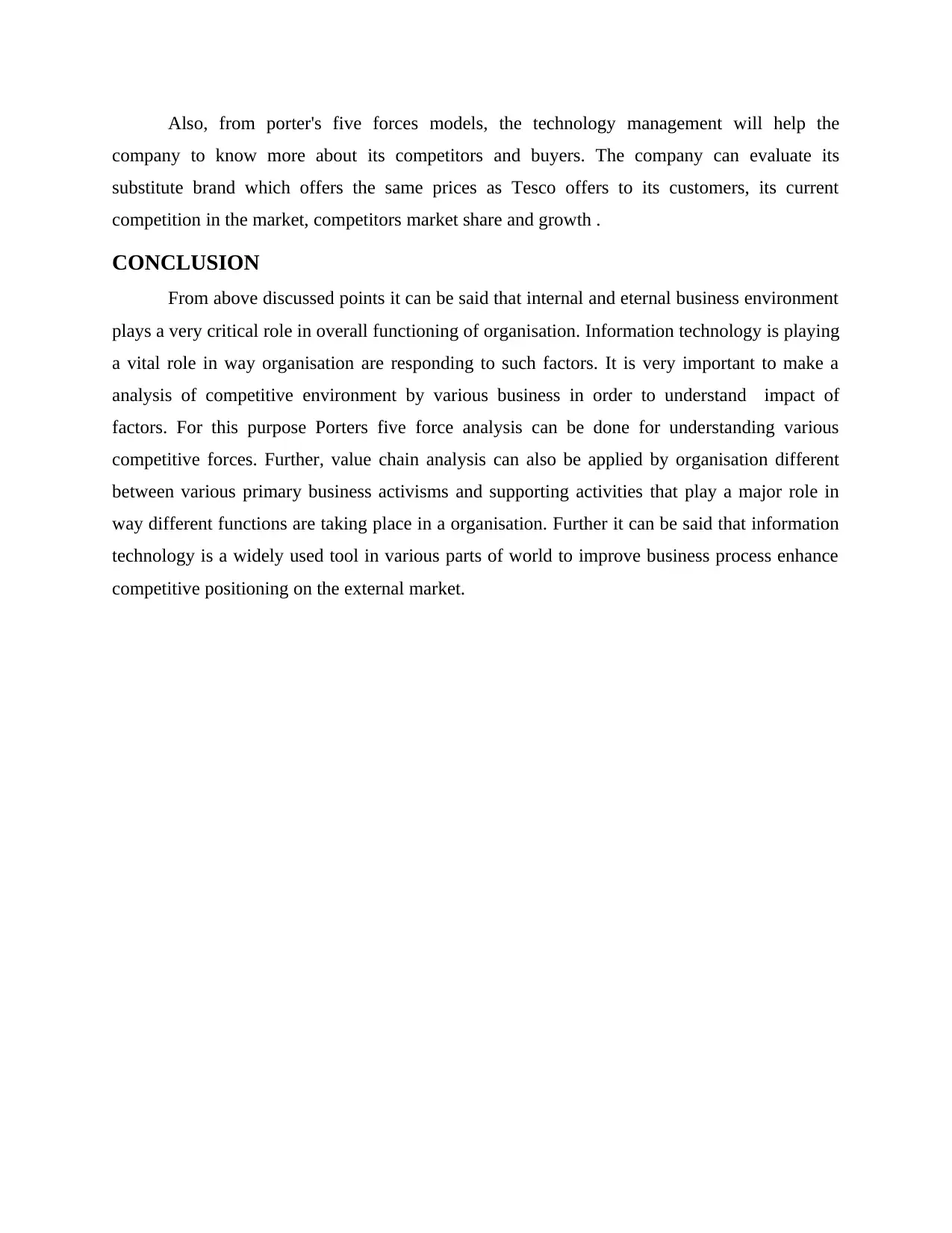
Also, from porter's five forces models, the technology management will help the
company to know more about its competitors and buyers. The company can evaluate its
substitute brand which offers the same prices as Tesco offers to its customers, its current
competition in the market, competitors market share and growth .
CONCLUSION
From above discussed points it can be said that internal and eternal business environment
plays a very critical role in overall functioning of organisation. Information technology is playing
a vital role in way organisation are responding to such factors. It is very important to make a
analysis of competitive environment by various business in order to understand impact of
factors. For this purpose Porters five force analysis can be done for understanding various
competitive forces. Further, value chain analysis can also be applied by organisation different
between various primary business activisms and supporting activities that play a major role in
way different functions are taking place in a organisation. Further it can be said that information
technology is a widely used tool in various parts of world to improve business process enhance
competitive positioning on the external market.
company to know more about its competitors and buyers. The company can evaluate its
substitute brand which offers the same prices as Tesco offers to its customers, its current
competition in the market, competitors market share and growth .
CONCLUSION
From above discussed points it can be said that internal and eternal business environment
plays a very critical role in overall functioning of organisation. Information technology is playing
a vital role in way organisation are responding to such factors. It is very important to make a
analysis of competitive environment by various business in order to understand impact of
factors. For this purpose Porters five force analysis can be done for understanding various
competitive forces. Further, value chain analysis can also be applied by organisation different
between various primary business activisms and supporting activities that play a major role in
way different functions are taking place in a organisation. Further it can be said that information
technology is a widely used tool in various parts of world to improve business process enhance
competitive positioning on the external market.
Secure Best Marks with AI Grader
Need help grading? Try our AI Grader for instant feedback on your assignments.
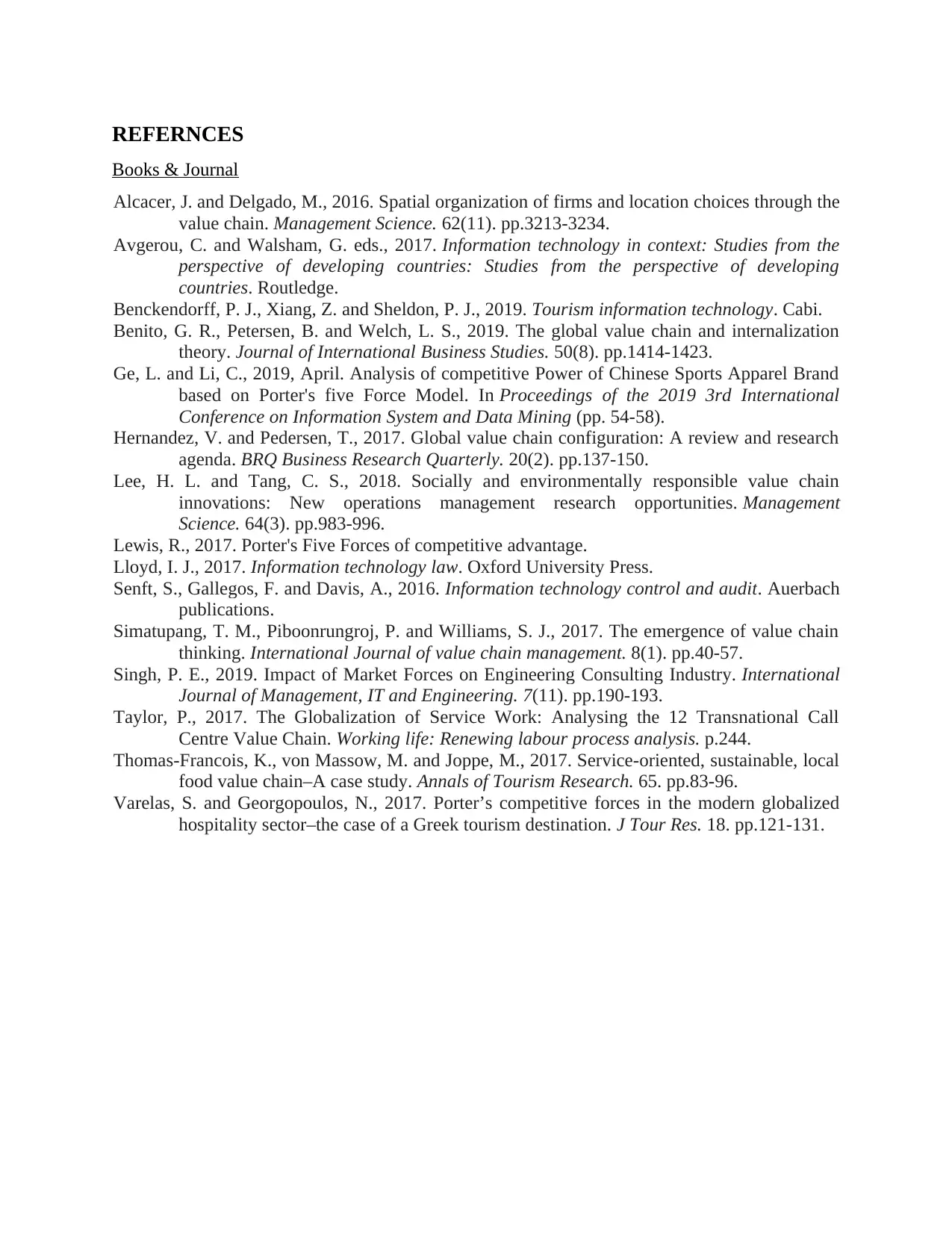
REFERNCES
Books & Journal
Alcacer, J. and Delgado, M., 2016. Spatial organization of firms and location choices through the
value chain. Management Science. 62(11). pp.3213-3234.
Avgerou, C. and Walsham, G. eds., 2017. Information technology in context: Studies from the
perspective of developing countries: Studies from the perspective of developing
countries. Routledge.
Benckendorff, P. J., Xiang, Z. and Sheldon, P. J., 2019. Tourism information technology. Cabi.
Benito, G. R., Petersen, B. and Welch, L. S., 2019. The global value chain and internalization
theory. Journal of International Business Studies. 50(8). pp.1414-1423.
Ge, L. and Li, C., 2019, April. Analysis of competitive Power of Chinese Sports Apparel Brand
based on Porter's five Force Model. In Proceedings of the 2019 3rd International
Conference on Information System and Data Mining (pp. 54-58).
Hernandez, V. and Pedersen, T., 2017. Global value chain configuration: A review and research
agenda. BRQ Business Research Quarterly. 20(2). pp.137-150.
Lee, H. L. and Tang, C. S., 2018. Socially and environmentally responsible value chain
innovations: New operations management research opportunities. Management
Science. 64(3). pp.983-996.
Lewis, R., 2017. Porter's Five Forces of competitive advantage.
Lloyd, I. J., 2017. Information technology law. Oxford University Press.
Senft, S., Gallegos, F. and Davis, A., 2016. Information technology control and audit. Auerbach
publications.
Simatupang, T. M., Piboonrungroj, P. and Williams, S. J., 2017. The emergence of value chain
thinking. International Journal of value chain management. 8(1). pp.40-57.
Singh, P. E., 2019. Impact of Market Forces on Engineering Consulting Industry. International
Journal of Management, IT and Engineering. 7(11). pp.190-193.
Taylor, P., 2017. The Globalization of Service Work: Analysing the 12 Transnational Call
Centre Value Chain. Working life: Renewing labour process analysis. p.244.
Thomas-Francois, K., von Massow, M. and Joppe, M., 2017. Service-oriented, sustainable, local
food value chain–A case study. Annals of Tourism Research. 65. pp.83-96.
Varelas, S. and Georgopoulos, N., 2017. Porter’s competitive forces in the modern globalized
hospitality sector–the case of a Greek tourism destination. J Tour Res. 18. pp.121-131.
Books & Journal
Alcacer, J. and Delgado, M., 2016. Spatial organization of firms and location choices through the
value chain. Management Science. 62(11). pp.3213-3234.
Avgerou, C. and Walsham, G. eds., 2017. Information technology in context: Studies from the
perspective of developing countries: Studies from the perspective of developing
countries. Routledge.
Benckendorff, P. J., Xiang, Z. and Sheldon, P. J., 2019. Tourism information technology. Cabi.
Benito, G. R., Petersen, B. and Welch, L. S., 2019. The global value chain and internalization
theory. Journal of International Business Studies. 50(8). pp.1414-1423.
Ge, L. and Li, C., 2019, April. Analysis of competitive Power of Chinese Sports Apparel Brand
based on Porter's five Force Model. In Proceedings of the 2019 3rd International
Conference on Information System and Data Mining (pp. 54-58).
Hernandez, V. and Pedersen, T., 2017. Global value chain configuration: A review and research
agenda. BRQ Business Research Quarterly. 20(2). pp.137-150.
Lee, H. L. and Tang, C. S., 2018. Socially and environmentally responsible value chain
innovations: New operations management research opportunities. Management
Science. 64(3). pp.983-996.
Lewis, R., 2017. Porter's Five Forces of competitive advantage.
Lloyd, I. J., 2017. Information technology law. Oxford University Press.
Senft, S., Gallegos, F. and Davis, A., 2016. Information technology control and audit. Auerbach
publications.
Simatupang, T. M., Piboonrungroj, P. and Williams, S. J., 2017. The emergence of value chain
thinking. International Journal of value chain management. 8(1). pp.40-57.
Singh, P. E., 2019. Impact of Market Forces on Engineering Consulting Industry. International
Journal of Management, IT and Engineering. 7(11). pp.190-193.
Taylor, P., 2017. The Globalization of Service Work: Analysing the 12 Transnational Call
Centre Value Chain. Working life: Renewing labour process analysis. p.244.
Thomas-Francois, K., von Massow, M. and Joppe, M., 2017. Service-oriented, sustainable, local
food value chain–A case study. Annals of Tourism Research. 65. pp.83-96.
Varelas, S. and Georgopoulos, N., 2017. Porter’s competitive forces in the modern globalized
hospitality sector–the case of a Greek tourism destination. J Tour Res. 18. pp.121-131.

1 out of 12
Related Documents
Your All-in-One AI-Powered Toolkit for Academic Success.
+13062052269
info@desklib.com
Available 24*7 on WhatsApp / Email
![[object Object]](/_next/static/media/star-bottom.7253800d.svg)
Unlock your academic potential
© 2024 | Zucol Services PVT LTD | All rights reserved.





